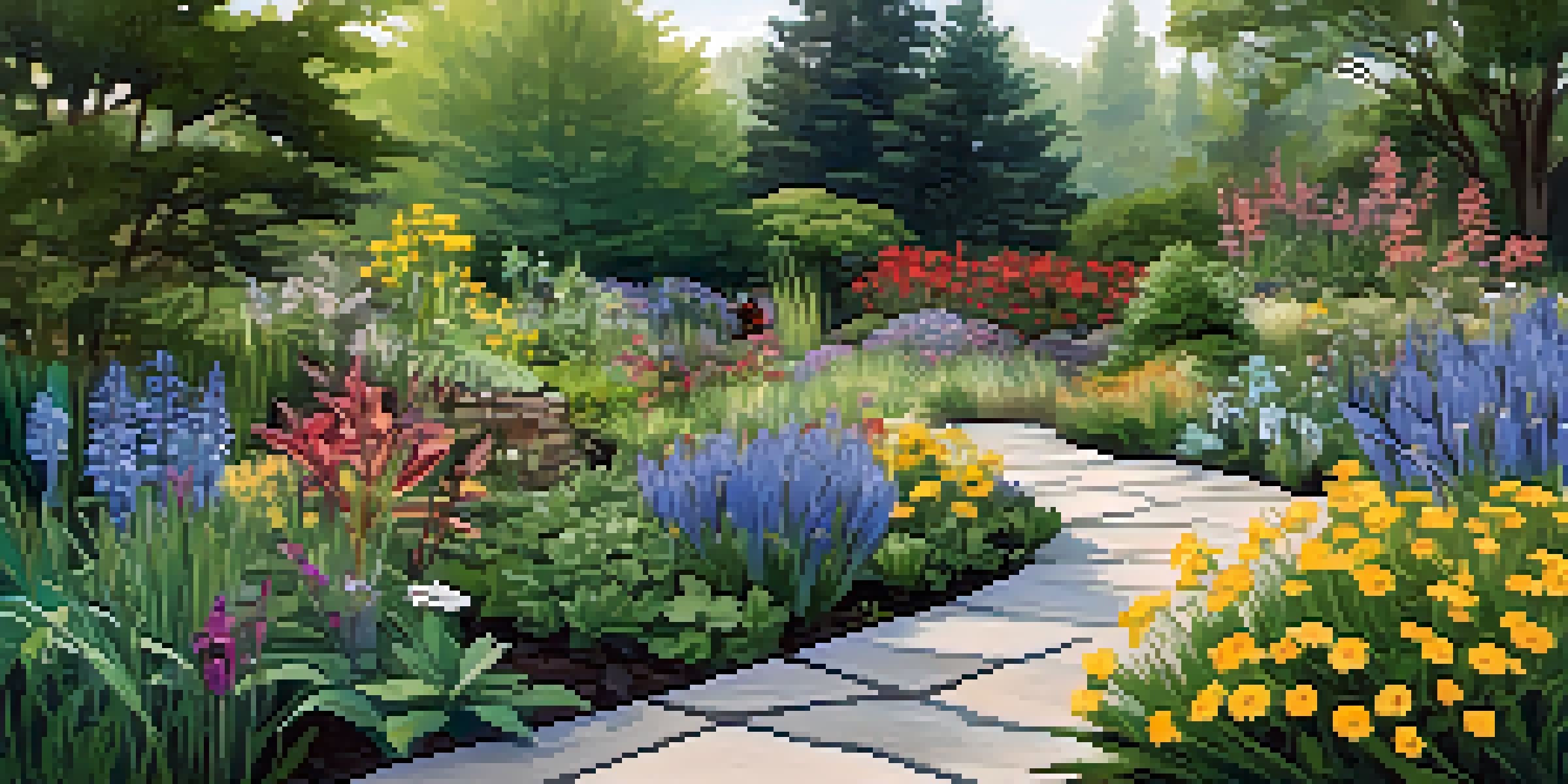Rain Gardens: Planting Strategies for Water Management

Understanding Rain Gardens and Their Benefits
Rain gardens are specially designed landscapes that capture and manage stormwater. They help to reduce runoff, filter pollutants, and recharge groundwater, making them a practical solution for urban environments. By mimicking nature, rain gardens play a crucial role in managing excess water and enhancing local ecosystems.
In every walk with nature one receives far more than he seeks.
One of the primary benefits of rain gardens is their ability to improve water quality. As rainwater flows through the garden, plants and soil work together to remove contaminants before the water reaches storm drains or local waterways. This natural filtration protects our rivers and lakes, promoting healthier aquatic habitats.
Additionally, rain gardens can provide aesthetic value to your property. With the right selection of plants, they can bloom beautifully, attract pollinators like bees and butterflies, and create a serene outdoor space. So, not only do they serve a functional purpose, but they also enhance the overall beauty of your landscape.
Choosing the Right Location for Your Rain Garden
The first step in creating a rain garden is selecting the ideal location. Look for areas where water naturally collects after rain, such as low spots or near downspouts. Avoid placing the garden too close to foundations or septic systems, as you want to ensure proper drainage and avoid any potential issues.

Make sure the chosen spot receives adequate sunlight, as most rain garden plants thrive in full to partial sun. A sunny location not only supports healthy plant growth but also encourages evaporation, helping to manage excess water. Testing the soil drainage beforehand can also help you determine whether the site is suitable for your rain garden.
Rain Gardens Enhance Water Quality
Rain gardens naturally filter pollutants from stormwater, improving the health of local waterways and ecosystems.
Once you've identified the perfect location, consider the size of your garden. It should be roughly 10% of the area that drains into it, allowing for efficient water capture. This balance ensures that the garden can effectively manage runoff while providing ample space for diverse plant life.
Selecting Plants for Your Rain Garden
Choosing the right plants is vital for the success of your rain garden. Opt for native plants that are adapted to your local climate and soil conditions, as they are more resilient and require less maintenance. Native plants also offer benefits to local wildlife, creating a thriving ecosystem.
The earth has music for those who listen.
Consider incorporating a mix of plants that can tolerate both wet and dry conditions, as rain gardens can experience fluctuations in moisture levels. Grasses, flowering perennials, and shrubs can all be effective choices. For example, plants like coneflowers and blue flag iris are not only beautiful but also excellent at handling varying water levels.
Grouping plants with similar water needs together can enhance the garden's effectiveness. This ensures that each plant receives the appropriate moisture while minimizing competition for resources. With thoughtful selection, your rain garden can flourish while serving its primary function of managing water.
Designing Your Rain Garden Layout
Designing your rain garden involves thoughtful planning to ensure it effectively captures and manages water. Start by sketching a layout that includes different plant zones, pathways, and any necessary retaining walls. This blueprint can help visualize how water will flow and where it will pool within the garden.
A gentle slope towards the center of the garden encourages water movement, preventing erosion and promoting infiltration. Additionally, incorporating curved lines in your design can create a more natural look, blending seamlessly with your landscape. Remember, the goal is both functionality and aesthetics.
Choose the Right Location
Selecting a suitable site with proper drainage and sunlight is crucial for the effective functioning of your rain garden.
Consider including features such as rocks or gravel to enhance drainage and provide a natural look. These elements can also serve as focal points, making your rain garden an attractive addition to your yard. Ultimately, a well-planned design will support the health of both the garden and the surrounding environment.
Preparing the Site for Your Rain Garden
Before planting, it's essential to prepare the site properly. Start by clearing any existing grass, weeds, or debris, which can compete with your new plants. Once the area is cleared, you can begin digging out the garden bed to create a shallow depression where water can collect.
Aim for a depth of about 6 to 12 inches, depending on the size of the garden and the type of soil. If your soil is particularly clay-heavy, consider amending it with organic matter to improve drainage. This will create a healthy environment for your plants and enhance the garden's water management capabilities.
After digging, you may want to outline the garden with garden edging or rocks to define its boundaries. This not only helps with aesthetics but also keeps mulch and soil in place. With the site prepared, you’re ready to move on to planting!
Planting Techniques for Your Rain Garden
When it comes to planting, timing is key. Early spring or fall are typically the best times to plant, as this allows roots to establish before extreme summer heat or winter cold. Start by placing your plants according to your design, keeping taller plants towards the back and shorter ones in front for visual layering.
Dig holes that are twice as wide as the plant's root ball and just as deep. This ensures that roots have plenty of room to spread and access nutrients. As you plant, gently loosen the roots and position them straight in the hole to promote healthy growth.
Ongoing Maintenance is Key
Regular maintenance, including weeding and watering, ensures the longevity and health of your rain garden.
After planting, water thoroughly to help settle the soil around the roots. Applying a layer of mulch can help retain moisture, suppress weeds, and provide a finished look. With these planting techniques, your rain garden will be well on its way to thriving while managing water effectively.
Maintaining Your Rain Garden for Longevity
Once your rain garden is established, ongoing maintenance will help ensure its success. Regularly check for weeds, as they can compete with your plants for resources. Pulling them out by hand or using mulch can help keep them at bay, allowing your chosen plants to flourish.
Watering is crucial, especially during the first few months after planting. While rain gardens are designed to manage water, new plants still need supplemental watering until they fully establish. Monitor the moisture levels, especially during dry spells, and adjust as needed.

Lastly, don't forget to enjoy your rain garden! Observe how it changes with the seasons and watch as wildlife comes to visit. With a little care and attention, your rain garden will not only manage water but also become a cherished part of your landscape.